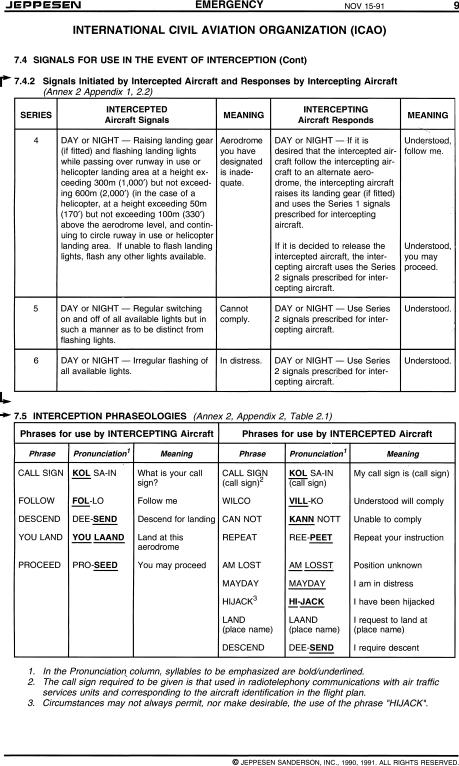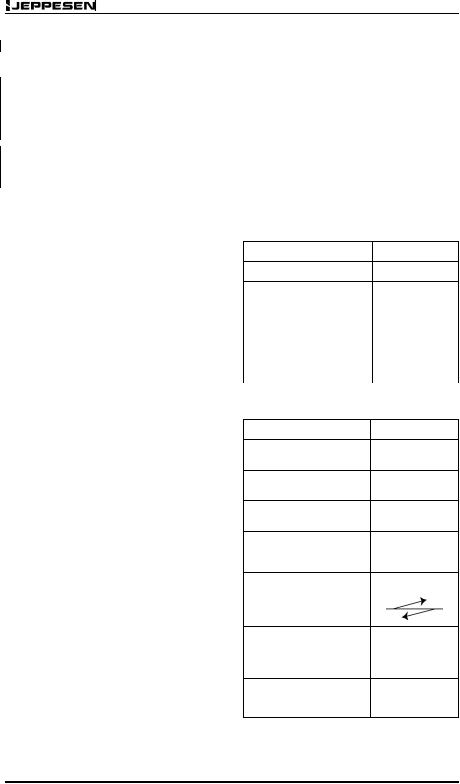

8 |
EMERGENCY |
24 FEB 06 |
INTERNATIONAL CIVIL AVIATION ORGANIZATION (ICAO)
7.4SIGNALS FOR USE IN THE EVENT OF INTERCEPTION
7.4.1Signals Initiated by Intercepting Aircraft and Responses by Intercepted Aircraft (Annex 2, Appendix 1, 2.1)
© JEPPESEN SANDERSON, INC. 1999, 2006. ALL RIGHTS RESERVED.


10 |
EMERGENCY |
24 FEB 06 |
INTERNATIONAL CIVIL AVIATION ORGANIZATION (ICAO)
NOTE: Where civil commercial aircraft take part in search and rescue operations, they will normally communicate on the appropriate enroute channels with the flight information center associated with the rescue co-ordination center concerned.
–type of craft in distress, its identification and condition;
–its position, expressed in geographical co-or- dinates or in distance and true bearing from a distinctive landmark or from a radio navigation aid;
–time of observation expressed in hours and minutes UTC;
–number of persons observed;
–whether persons have been seen to abandon the craft in distress;
–apparent best ground access route to the distress site; and
d.act as instructed by the rescue co-ordination center or the air traffic services unit.
(Annex 12, 5.6.2)
8.3.2If the first aircraft to reach the scene of an accident is not a search and rescue aircraft it shall take charge of on-scene activities of all other aircraft subsequently arriving until the first search and rescue aircraft reaches the scene of the accident. If, in the meantime, such aircraft is unable to establish communication with the appropriate rescue co-ordination center or air traffic services unit, it shall, by mutual agreement, hand over to an aircraft capable of establishing and maintaining such communications until the arrival of the first search and rescue aircraft. (Annex 12, 5.6.2.1)
8.3.3When it is necessary for an aircraft to direct a surface craft to the place where an aircraft or surface craft is in distress, the aircraft shall do so by transmitting precise instructions by any means at its disposal. If no radio communication can be established the aircraft shall use the appropriate visual signal in paragraph 8.4. (Annex 12, 5.6.5)
8.3.4When it is necessary for an aircraft to convey information to survivors or surface rescue units, and two-way communication is not available, it shall, if practicable, drop communication equipment that would enable direct contact to be established, or convey the information by dropping a hard copy
message. (Annex 12, 5.6.3)
8.3.5 When a ground signal has been displayed, the aircraft shall indicate whether the signal has been understood or not by the means described in 8.3.4 or, if this is not practicable, by use of the appropriate visual signal in paragraph 8.4. (Annex 12, 5.6.4)
© JEPPESEN SANDERSON, INC. 1999, 2006. ALL RIGHTS RESERVED.

24 FEB 06 |
EMERGENCY |
11 |
INTERNATIONAL CIVIL AVIATION ORGANIZATION (ICAO) 8.4 SEARCH AND RESCUE SIGNALS
8.4.1 |
General |
8.4.3 |
Ground-Air Visual Signal Code |
||
8.4.1.1 |
The air-to-surface and surface-to-air |
8.4.3.1 |
Symbols shall be at least 2.5m (8') |
||
visual signals in this section shall, when used, have |
long and shall be made as conspicuous as possible. |
||||
the meaning indicated therein. They shall be used |
(Annex 12, Appendix A, 2.3) |
||||
only for the purpose indicated and no other signals |
NOTE: |
|
|||
likely to be confused with them shall be used. (An- |
|
||||
1. |
Symbols may be formed by any means such as: |
||||
nex 12, 5.8.1) |
|||||
|
strips of fabric, parachute material, pieces of |
||||
8.4.1.2 |
Upon observing any of the signals |
|
|||
|
wood, stones or such like material; marking the |
||||
given in this section, aircraft shall take such action |
|
surface by tramping, or staining with oil, etc. |
|||
as may be required by the interpretation of the signal |
2. |
Attention to the signals may be attracted by oth- |
|||
given. (Annex 12, 5.8.2) |
|||||
|
er means such as radio, flares, smoke, reflected |
||||
|
|
|
|||
8.4.2 |
Signals with Surface Craft |
|
light, etc. |
||
NOTE: The following replies may be made by sur- |
8.4.3.2 |
Ground-air Visual Signal Code For |
|||
face craft to the signal in 8.4.2.1: |
|
|
Use By Survivors (Annex 12, |
||
|
|
Appendix A, 2.1) |
|||
– For acknowledging receipt of signals: |
|
|
|||
|
|
|
|||
1. the hoisting of the “Code pennant” (vertical |
|
|
|
||
|
red and white stripes) close up (meaning un- |
|
|
|
|
|
derstood); |
|
|
|
|
2. the flashing of a succession of “T’s” by sig- |
|
|
|
||
|
nal lamp in the Morse code; |
|
|
|
|
3. |
the changing of heading to follow the air- |
|
|
|
|
|
craft. |
|
|
|
|
– For indicating inability to comply: |
|
|
|
||
1. |
the hoisting of the international flag “N” (a |
|
|
|
|
|
blue and white checkered square); |
|
|
|
|
2. |
the flashing of a succession of “N’s” in the |
|
|
|
|
|
Morse code. |
|
|
|
|
8.4.2.1 The following maneuvers performed in sequence by an aircraft mean that the aircraft wishes to direct a surface craft towards an aircraft or a surface craft in distress:
a.circling the surface craft at least once;
b.crossing the projected course of the surface craft close ahead at low altitude and:
1. rocking the wings; or
2.opening and closing the throttle; or
3.changing the propeller pitch.
NOTE: Due to high noise level on-board surface craft, the sound signals in (2) and (3) may be less effective than the visual signal in
(1) and are regarded as alternative means of attracting attention.
c.heading in the direction in which the surface craft is to be directed.
Repetition of such maneuvers has the same meaning. (Annex 12, Appendix A, 1.1)
8.4.2.2 The following maneuver by an aircraft means that the assistance of the surface craft to which the signal is directed is no longer required:
–crossing the wake of the surface craft close astern at a low altitude and:
a.rocking the wings; or
b.opening and closing the throttle; or
c.changing the propeller pitch.
(Annex 12, Appendix A, 1.2)
© JEPPESEN SANDERSON, INC. 1999, 2006. ALL RIGHTS RESERVED.

12 |
EMERGENCY |
24 FEB 06 |
INTERNATIONAL CIVIL AVIATION ORGANIZATION (ICAO)
8.4.3.4Air-to-ground Signals
8.4.3.4.1 The following signals by aircraft mean that the ground signals have been understood:
a.during the hours of daylight:
–by rocking the aircraft’s wings;
b.during the hours of darkness:
–flashing on and off twice the aircraft’s landing lights or, if not so equipped, by switching on and off twice its navigation lights. (Annex 12, Appendix A, 3.1)
8.4.3.4.2 Lack of the above signal indicates that the ground signal is not understood. (Annex 12, Appendix A, 3.2)
© JEPPESEN SANDERSON, INC. 1999, 2006. ALL RIGHTS RESERVED.

14 OCT 05 |
EMERGENCY |
AFGHANISTAN-1 |
ICAO DIFFERENCES OR STATE SPECIAL PROCEDURES
GENERAL
In general, the Emergency, Unlawful Interference, Communications Failure, Interception and Search and Rescue procedures are in conformity with the Standards, Recommended Practices and Procedures in ICAO Annexes and Documents.
EQUIPMENT FAILURE PROCEDURES
Crews shall advise ATC when any deterioration or failures of the navigation equipment below the navigation performance requirements are encountered or if any deviations are required for contingency procedures. At a minimum, the following information shall be transmitted:
a.call sign;
b.flight level;
c.direction of flight;
d.position.
Crews shall advise ATC of any deterioration or failure of navigation equipment below RNP-10 navigation performance requirements by stating “Unable RNAV due to equipment”.
© JEPPESEN SANDERSON, INC. 2001, 2005. ALL RIGHTS RESERVED.

18 MAR 05 |
EMERGENCY |
ALBANIA-1 |
ICAO DIFFERENCES OR STATE SPECIAL PROCEDURES
GENERAL
In general, the Emergency, Unlawful Interference, Communications Failure, Interception and Search and Rescue procedures are in conformity with the Standards, Recommended Practices and Procedures in ICAO Annexes and Documents.
COMMUNICATION FAILURE
See EMERGENCY page E-22.
© JEPPESEN SANDERSON, INC., 1989, 2005. ALL RIGHTS RESERVED.

14 OCT 05 |
EMERGENCY |
ALGERIA-1 |
ICAO DIFFERENCES OR STATE SPECIAL PROCEDURES
GENERAL
In general, the Emergency, Unlawful Interference, Communications Failure, Interception and Search and Rescue procedures are in conformity with the Standards, Recommended Practices and Procedures in ICAO Annexes and Documents.
COMMUNICATIONS FAILURE
EMERGENCY SATELLITE VOICE CALLS
FROM AIRCRAFT
For aircraft flying in Algiers FIR/UIR, in the event that all other means of communication have failed, dedicated satellite voice telephone numbers for Algiers ACC have been programmed into the aeronautical Ground Earth Stations of the Inmarsat Signatories. The allocated airborne numbers for use via the aircraft satellite voice equipment are as follows:
Algiers ACC
Tel: 00871763645324
00871763645325
It must be emphasized that these numbers are for emergency only, when all other airborne means of communication with the appropriate ATS unit have failed.
© JEPPESEN SANDERSON, INC. 1997, 2005. ALL RIGHTS RESERVED.

7 OCT 05 |
EMERGENCY |
AUSTRIA-1 |
ICAO DIFFERENCES OR STATE SPECIAL PROCEDURES
GENERAL
In general, the Emergency, Unlawful Interference, Communications Failure, Interception and Search and Rescue procedures are in conformity with the Standards, Recommended Practices and Procedures in ICAO Annexes and Documents.
COMMUNICATIONS FAILURE
See EMERGENCY PAGE E-22.
AIRCRAFT DEPARTING VIENNA (SCHWECHAT)
The following procedure shall be observed when experiencing radio communication failure (except for ABLOM, KOVEL, LANUX, MIKOV, SASAL and STEIN departures):
–squawk A 7600 and maintain 5000ft MSL until distance 20 DME FMD;
–then climb to FL120 (or to the filed flight level if below FL120);
–maintain FL120 for a period of 3 minutes, then climb to the cruising level filed in the flight plan.
AIRCRAFT DEPARTING SALZBURG
The following procedures shall be observed when experiencing radio communication failure:
–LIMRA departures:
•squawk A 7600 and maintain FL60 until distance 13 DME SBG;
•then climb to FL120;
•maintain FL120 for a period of 3 minutes, then climb to the cruising level filed in the flight plan.
–RASTA departures:
•squawk A 7600 and maintain FL100 until distance 12 DME SBG;
•then climb to FL120, or to the cleared flight level;
•maintain FL120, or the cleared flight level, for a period of 3 minutes, then climb to the cruising level filed in the flight plan.
© JEPPESEN SANDERSON, INC. 1993, 2005. ALL RIGHTS RESERVED.

27 FEB 04 |
EMERGENCY |
AZERBAIJAN-1 |
ICAO DIFFERENCES OR STATE SPECIAL PROCEDURES
# GENERAL
In general, the Emergency, Unlawful Interference, Communications Failure, Interception and Search and Rescue procedures are in conformity with the Standards, Recommended Practices and Procedures in ICAO Annexes and Documents.
COMMUNICATION FAILURE
RADAR FAILURE
In the event of Radar failure or loss of radar identification, instruction will be issued to the pilot to increase separation up to the values prescribed for flights without radar control:
-at least 10 minutes for aircraft proceeding at the same level along the same route;
-at least 20 minutes at the moment of crossing when crossing the same or opposite direction flight level occupied by another aircraft;
-at least 3 minutes when performing approach manoeuvres in control zone.
RADIO FAILURE
The Radar controller will establish whether the aircraft radio receiver is working by instructing the pilot to carry out turns, if turns are observed the radar controller will continue to provide radar service.
If the aircraft’s radio is completely unserviceable, the pilot should carry out the procedures for communication failure in accordance with ICAO. If radar identification has already been established, the radar controller will vector other identified aircraft clear of its track until such time as the aircraft leaves the radar cover.
"! END
© JEPPESEN SANDERSON, INC., 2004. ALL RIGHTS RESERVED.

27 MAY 05 |
EMERGENCY |
BAHRAIN-1 |
ICAO DIFFERENCES OR STATE SPECIAL PROCEDURES
GENERAL
In general, the Emergency, Unlawful Interference, Communications Failure, Interception and Search and Rescue procedures are in conformity with the Standards, Recommended Practices and Procedures in ICAO Annexes and Documents.
EMERGENCY RUNWAY PROCEDURE
Due to the physical restrictions imposed on the traffic movement of the Bahrain (Int’l) airfield during the operation of the emergency runway, the use of such runway shall strictly be allowed during emergency periods only.
Aircraft intending to land on the emergency runway shall, after being well-established on the final approach segment on an instrument approach for runway 30R or runway 12L, attempt to establish visual contact with the emergency runway at a distance of not less than 4NM from the threshold, if the emergency runway is visible, the pilot may execute a visual side-step manoeuvre and continue a visual approach to the emergency runway. If no visual contact has been made with the emergency runway before crossing 4NM on final approach segment, the pilot shall initiate a missed approach as per the main runway procedures, inform air traffic control and follow ATC instructions.
If a normal landing can not be made after the side-step manoeuvre has been executed and the aircraft is within 4NM in line with final approach leg of the emergency runway, the pilot shall:
a.For emergency RWY 30L: Climb 2500ft on track 301°, when level, turn right to rejoin the hold or as instructed by ATC.
b.For emergency RWY 12R: Climb 2500ft on track 120°, when level, turn left to rejoin the hold or as instructed by ATC.
COMMUNICATIONS FAILURE
In VMC: ICAO Procedure.
In IMC: ICAO Procedure, supplemented as follows:
DEPARTING AIRCRAFT UNDER RADAR
CONTROL
If departing from Bahrain (Intl) airport on a radar clearance and experiencing complete radio communication failure maintain the last assigned heading and flight level or altitude for a period of 3 minutes after departure or to a distance of 12 DME Bahrain VORDME ‘BAH’ whichever occurs earlier. Thereafter continue according to the current flight plan by routing direct to the first enroute reporting point and climbing to the last acknowledged enroute flight level cleared by ATC.
© JEPPESEN SANDERSON, INC., 1993, 2005. ALL RIGHTS RESERVED.

30 JAN 04 |
EMERGENCY |
BELARUS-1 |
ICAO DIFFERENCES OR STATE SPECIAL PROCEDURES
GENERAL
In general, the Emergency, Unlawful Interference, Communications Failure, Interception and Search and Rescue procedures are in conformity with the Standards, Recommended Practices and Procedures in ICAO Annexes and Documents.
COMMUNICATIONS FAILURE
See EMERGENCY PAGE EE-22, and supplemented as follows:
#After entry into TMA continue flight at last assigned flight level to LOM of destination aerodrome. Descent for approach shall commence not earlier than ETA and landing shall be carried out not later than 30 minutes after ETA.
If radio communication failure appears during final approach and the meteorological conditions are below minimum, pilot-in-command has the right to land under current conditions.
After take-off the pilot-in-command shall operate according to the approach pattern and land at the departure aerodrome under meteorological conditions below minimum. A listening watch on the LOM frequency obtaining ATC instructions and information is necessary.
If meteorological conditions or other reasons do not allow landing at the departure aerodrome, pilot- in-command has the right:
-proceed to the destination aerodrome climbing to the flight level indicated in the FPL according to departure pattern;
-proceed to the alternate aerodrome at the flight level selected by the pilot not below safe
"! flight level.
END
© JEPPESEN SANDERSON, INC., 1989, 2004. ALL RIGHTS RESERVED.
